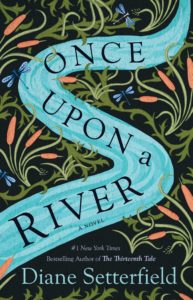Once Upon a River by Diane Setterfield
 Once Upon A River
Once Upon A River
by Diane Setterfield
Ms. Setterfield’s The Thirteenth Tale is one of my all-time favorite novels – it holds a place of honor on my shelf, so I was excited to receive an advance reading copy of her newest novel, Once Upon A River.
What a journey I’ve been on, what a tale I’ve been told. Pull up a chair here by the fire and let me tell you more
It was solstice night, the longest night of the year… And as the borders between night and day stretch to their thinnest, so too do the borders between worlds… Unexpected things can happen. Did the solstice have anything to do with the strange events at the Swan? You will have to judge for yourself.
The novel opens on the winter solstice of 1887 at The Swan, a pub on the Thames River in England. The Swan is where drinking patrons gather to tell and hear stories. The stories are suddenly interrupted by the appearance of a badly injured stranger at the door, carrying a dead little girl. When the child, who had no signs of life, hours later begins to breathe again, everyone wonders who or what she is. A miracle? A river sprite? A magic being? Who is the injured man, not the father, but carrying the little girl? Whatever she may be, once revived, three different people claim her as their own lost little girl.
But in describing the basic premise, I am short shifting Once Upon a River. This is a rich and complex novel. A lyrical fairy tale steeped in the art of story telling and painted with its river setting symbolism. I was completely enveloped in this fascinatingly entwined story of the little girl, the mysterious injured man, the families, and the various patrons who witnessed the miracle. Like any good fairy tale, we’re never sure what’s myth or reality. A woman with an patch over an eye that has the power to see deep into people’s souls and there’s Quietly – the river’s mythical guardian who watches over all who cross or boat upon it.
Don’t be put off by the size of this novel – it’s a chunkster – but Ms. Setterfield has carefully woven the stories together so that you’re eager to visit with each character to hear their side of the story — their version of the history. The stories swirl along the river and back and forth in time. The river itself, the Thames, is not just a setting, it serves both as character and metaphor — the reader and the story follow its twists, ebbs and flows — straining to see what’s around the next bend…
It finds its way into wells and is drawn up to launder petticoats and be boiled for tea. It is sucked into root membranes, travels up cell by cell to the surface, is held in the leaves of watercress that find themselves in the soup bowls and on the cheeseboards of the county’s diners. From teapot or soup dish, it passes into mouths, irrigates complex internal biological networks that are worlds in themselves, before returning eventually to the earth via a chamber pot. Elsewhere the river water clings to the leaves of the willows that droop to touch its surface and then, when the sun comes up, a droplet appears to vanish into the air, where it travels invisibly and might join a cloud, a vast floating lake, until it falls again as rain. This is the unmappable journey of the Thames.
Admittedly, there are lots (and lots) of characters, but even this poor old brain was able to keep them straight – a testament to the writing. Ahhh, the writing – Ms. Setterfield is the master chef of storytelling — mixing folklore into a mystery and sprinkling in some magical happenings. I found it impossible to rush this novel — and fair warning, some may find it tedious — but not I. I deliberately slowed down my usual rapid reading to savor many beautiful sentences…such as this:
They were collectors of words the same way so many of the gravel diggers were collectors of fossils. They kept an ear constantly alert for them, the rare, the unusual, the unique
and this:
There are stories that may be told aloud, and stories that must be told in whispers, and there are stories that are never told at all.
Once Upon a River had me spellbound for days (and nights). Ms. Setterfield shows the import of stories to shape and define lives. How stories change the past, hide secrets, form resentments, teach us how to love and be loved — and in the end, to flourish as humans.
I’ll leave you with this from the ending (and a recommendation to also read The Thirteenth Tale):
And now, dear reader, the story is over. It is time for you to cross the bridge once more and return to the world you came from. This river, which is and is not the Thames, must continue flowing without you. You have haunted here long enough, and besides, you surely have rivers of your own to attend to?
A digital advanced readers copy was kindly provided by Atria Books via Netgalley.






I don’t have superlatives enough for that book! Simply wonderful!
I used every superlative I could fit in my review – now off to re-read Thirteenth Tale. Have you read it?